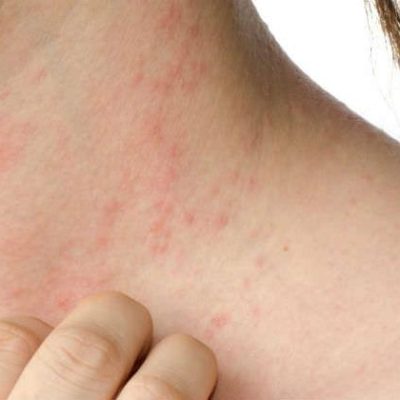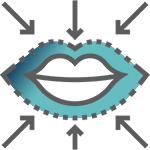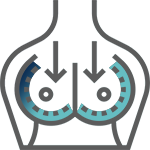Atopic Eczema (Atopic Dermatitis)
Atopic Eczema
Atopic eczema is a chronic inflammatory condition of the skin. Atopic is the term used to describe conditions such as eczema, asthma, seasonal rhinitis and hay fever, which often have a genetic basis. Eczema is the term used to describe changes in the upper layer of the skin that include redness, blistering, oozing, crusting, scaling, thickening and sometimes pigmentation. Atopic eczema affects both sexes equally and usually starts in the first weeks or months of life. It is most common in children, affecting at least 10% of infants at some stage. It usually disappears during childhood, although it can carry on into adult life or come back in the teenage or early adult years. It may occasionally develop for the first time in adulthood.
The main characteristic is severe pruritus (Itching) and dry lesions in different parts of the body. It appears in crops, with variable intensity and duration, and with clear phases in most of the cases. The skin is very sensitive to a number of stimuli and has a higher susceptibility to certain skin infections like staph.
What causes atopic eczema? This is still not fully understood. A tendency to atopic conditions often runs in families. In people with atopic eczema, the function of their skin as a barrier to the outside world does not work well, so that irritant and allergy-inducing substances enter their skin causing inflammation and due to water loss cause dryness. Atopic eczema is not catching.

What are the symptoms of atopic eczema?
The main symptom is itch. Scratching in response to itch may be the cause for many of the changes seen on the skin. Itching can be bad enough to interfere with sleep, causing tiredness and irritability.
What does atopic eczema look like?
Atopic eczema can affect any part of the skin, including the face, but the areas most commonly affected are the bends of the elbows and knees, and around the wrists and neck (a flexural pattern). Other common appearances of atopic eczema include discrete coin-sized areas of inflammation (a discoid pattern), and numerous small bumps that coincide with the hair follicles (a follicular pattern). If you have eczema, it is likely your skin will be red and dry, and scratch marks (and bleeding) are common. When the eczema is very active (during a ‘flare-up’) you may develop small water blisters, or oozing. In areas that are repeatedly scratched, the skin may thicken up (a process known as lichenification).
What makes atopic eczema flare up?
Many factors in a person’s environment can make eczema worse. These include heat, dust and contact with irritants such as soap or detergents
Being unwell: for example having a common cold can make eczema flare Infections with bacteria or viruses can make eczema worse. Bacterial infection (usually with a bug called Staphylococcus) makes the affected skin yellow, crusty and inflamed, and may need treatment with antibiotics. An infection with the virus that causes cold sores (herpes simplex virus) can cause a painful widespread (and occasionally dangerous) flare of eczema, and may need treatment with antiviral tablets Dryness of the skin Perhaps stress.
How is atopic eczema diagnosed?
It is usually easy for health care professionals, such as health visitors, practice nurses and general practitioners, to diagnose eczema when they look at the skin. However, sometimes the pattern of eczema in older children and adults is different, and the help of a dermatologist may be needed. Blood tests and skin tests are usually not necessary. Occasionally the skin may need to be swabbed (by rubbing a sterile cotton bud on it) to check for bacterial or viral infections.
Can atopic eczema be cured?
No, it cannot be cured, but there are many ways of controlling it. Most children with atopic eczema improve as they get older (75% clear by their teens). However, many of those who have had eczema continue to have dry skin and need to avoid irritants such as soaps or bubble baths. Eczema may persist in adults, but it should be controllable with the right treatment. Atopic eczema may be troublesome for people in certain jobs that bring them into contact with irritant materials, such as catering, hairdressing or nursing.
What can I do?
Moisturize your skin as often as possible – maybe as often as 6 times each day. A bland, unperfumed moisturizer is best. This is the most important part of your skin care.
Wash with a soap substitute. Try to avoid using soap, bubble baths, shower gels and detergents.
Wear gloves to protect your hands if they are likely to come into contact with irritants.
Shower well after swimming, and apply plenty of your moisturizer after drying.
Wear comfortable clothes made of materials such as cotton, and avoid wearing wool next to your skin.
Try to resist the temptation to scratch. It may relieve your itch briefly, but it will make your skin itchier in the long term. Massage a moisturizer onto itchy skin.
Do not keep pets to which there is an obvious allergy.
How can atopic eczema be treated?
You will need the advice of a health care professional on the best treatment for your eczema and on how long this should continue. The regime used most often in the treatment of atopic eczema consists of moisturizers and topical steroids.Medidas preventivas:
Moisturizers (emollients): These should be applied every day to help the outer layer of your skin function as a barrier to your environment. The dryer your skin, the more frequently should you apply a moisturizer. Many different ones are available, varying in their degree of greasiness, and it is important that you choose one you like to use. A moisturizer in your bath or shower is a good idea.
Topical steroid creams or ointments: These will usually settle the redness and itching of your eczema when it is active. They come in different strengths (mild, moderately-potent, potent and very potent), and your doctor will advise you on which type needs to be used where, and for how long. Used inappropriately (too strong or for too long), topical steroids may cause side effects, including thinning of the skin, but they are very safe as long as they are used correctly – using the right strength to settle a flare up and stopping them or reducing their strength once things have improved. Doctors vary in their preference for how to stop topical steroids: some may suggest they are stopped abruptly, others may prefer to gradually decrease the potency of the steroid preparation, and yet others will advise a “maintenance regime” of using them intermittently for a few weeks after a flare of eczema has settled.
Antibiotics and antiseptics: If your eczema becomes wet, weepy and crusted, it may mean that it is infected and that a course of antibiotic is needed. Antiseptics, when applied to the skin alone or as part of a moisturizing preparation, can be very helpful in stopping the growth of bugs, although a possible side effect is that they may irritate the skin.
Topical immunosuppressants (calcineurin inhibitors):Some people with atopic eczema find the relatively new calcineurin inhibitor, tacrolimus ointment effective in reducing the inflammation of their skin. They are not steroids and thus do not thin the skin, nor cause the other side effects associated with topical steroids. Their commonest side effect is stinging on application, which quickly disappears. They may increase risk of skin infections and, thus, should not be applied to obviously infected skin. Theoretically at least, they might increase the risk of skin cancer, and therefore should not be applied to sun-exposed sites in the long term, nor used at the same time as ultraviolet light treatment.
Antihistamines:Your doctor may recommend antihistamine tablets, which in certain patients can be helpful. Those antihistamines that make people sleepy (such as chlorphenamine and hydroxyzine) may help the itch of atopic eczema, although they are less effective if used in the long term.
Bandaging (dressings):The use of medicated paste bandages can sometimes be very helpful, as they are soothing and provide a physical barrier to scratching. ‘Wet wraps’ are cooling bandages that are sometimes helpful for short periods. If the skin is infected, appropriate treatment is necessary if dressings are being considered. Your doctor or nurse will advise you regarding the suitability of dressings.
Ultraviolet light:Some people with chronic eczema benefit from ultraviolet light treatment, which is usually given in a specialist hospital department and supervised by a dermatologist.
Stronger treatments: People with severe or widespread atopic eczema sometimes need stronger treatments, which dampen down the immune system, and these will usually be given under the close supervision of a dermatologist. These include:
Stronger treatments: People with severe or widespread atopic eczema sometimes need stronger treatments, which dampen down the immune system, and these will usually be given under the close supervision of a dermatologist. These include:
People with severe or widespread atopic eczema sometimes need stronger treatments, which dampen down the immune system, and these will usually be given under the close supervision of a dermatologist. These include:
Azathioprine
Cyclosporine
Treatments that are not recommended:
‘Natural’ herbal creams, as they can cause irritation and allergic reactions. Their use on broken and inflamed skin is therefore not recommended.


STAFF
NURSE GRADUATED FROM CUC
CERTIFICATE PROGRAM IN WOUND HEALING
Monica
Padilla

STAFF
RECEPTION AND SALES
Betsy
Aguirre

Marisol
Pelayo

STAFF
CERTIFIED COSMETOLOGIST


STAFF
CERTIFIED COSMETOLOGIST
Esmeralda
Alcaraz


STAFF
RECEPTION AND SALES
Lolita
Simental

Creation
Proin at varius arcu. Sed posuere orci bibendum pharetra dapibus.

Analyses
Proin at varius arcu. Sed posuere orci bibendum pharetra dapibus.

Marketing
Proin at varius arcu. Sed posuere orci bibendum pharetra dapibus.
Choose the perfect product for you
ADDRESS
Derma Health Av. Los Tules 158, Col. Díaz Ordaz Puerto Vallarta
SCHEDULE
- Mon-Fri 9:00 am a 5:00 pm
- Saturday 9:00 am a 14:00 pm
- Sunday closed
- Copyright 2023. All rights reserved.